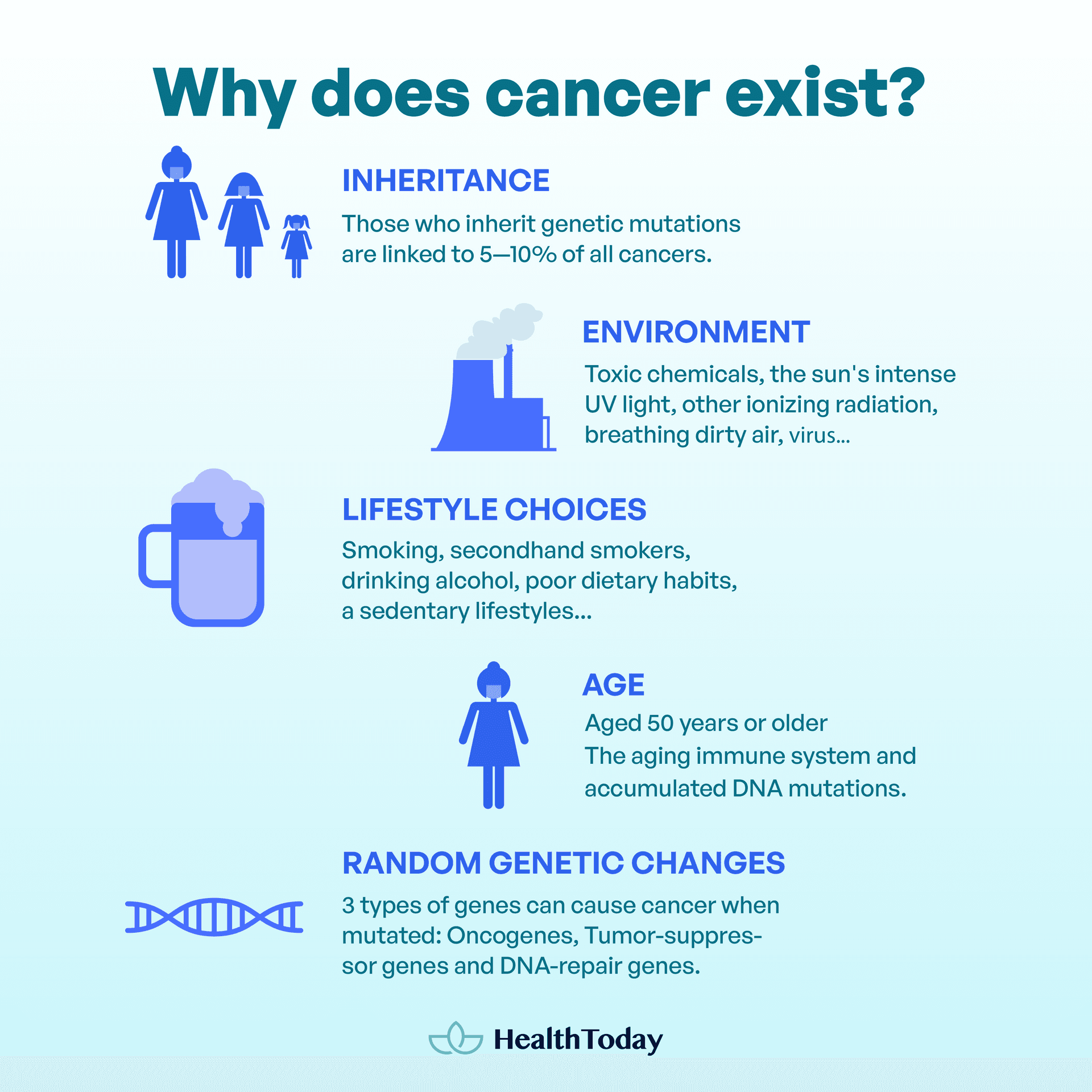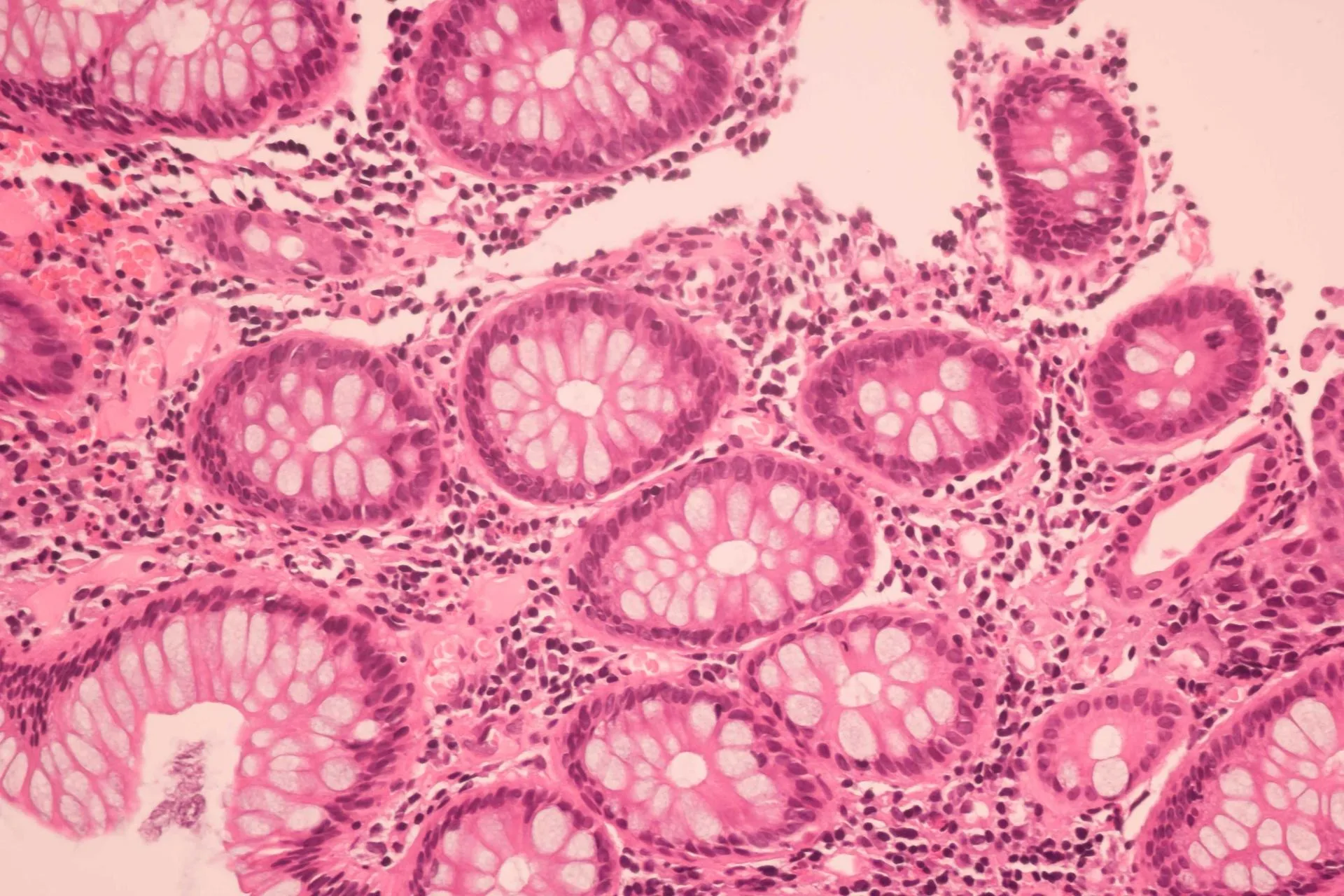Table of Contents
Cancer is a word that many people are familiar with, but what are cancer cells? When comparing cancer cells vs. normal cells, one may notice their potential to multiply uncontrollably. What exactly makes this happen?
In this article, we’ll explain the complex working mechanism of cancer cells, distinguishing them from other cells. Also, you’ll have a better understanding of “How fast do tumors grow?” and how to assess your own cancer risk.
What are cancer cells?
Cancer is a group of hundreds of diseases that can start anywhere in our body (1).
Cancer remains the second leading cause of death in the US and the leading cause of death worldwide despite all the advancements. Worldwide, almost 10 million deaths in 2020 were caused by cancer (2, 3).
The rapid (uncontrollable) cell division and the invasive nature of abnormal cells are common characteristics of cancer. These cells can overgrow, forming a tumor (lumps of tissue) and disrupting the body’s normal function (1, 4).
Some tumors might not be cancerous, but others are malicious and are called “malignant tumors” (1).
Role of the Immune system in cancer prevention
Our bodies have a natural mechanism that helps tackle this harmful development, which is our immune system.
In other words, our immune system can help us eliminate waste and abnormal cells before they go and develop into cancer (5).
Moreover, some parts of our immune system can also help stop cancer growth (6).
The first line of defense is innate immunity, containing myeloid and nature killer (NK) cells. They can detect cell abnormalities, such as changes in surface proteins, and then release toxic substances to induce cancer cell death. Moreover, certain myeloid cells engulf and digest cancer cells (7, 8).
Dendritic cells, a myeloid cell type, can stimulate other immune cells. Those ‘helper’ cells have the ability to gain memory. That’s why each time they perform, they can get stronger. This, in turn, contributes to our long-term immune surveillance against cancer recurrence (9, 10).
There are more than 100 types of cancer characterized by uncontrollable cell division and the invasive behavior of abnormal cells. It can potentially trigger tumor formation and disrupt your normal functions. Our immune system can safeguard us from cancer by identifying and sniffing out those cancer cells.
Cancer cells vs. normal cells
Usually, our cells divide and make new cells whenever our body needs them. When cells start aging or getting damaged, it’s time for them to peace out. Then, new cells come in and replace them (1).
Unlike normal cells, cancer cells can evade (trick) those aging or replacing signals.
Besides the ability to constantly grow and divide, most cancer cell types share a few traits that are far different from normal cells (4).
Shape and structure: Cancer cells have a big, unevenly-shaped nucleus (heart of the cell that contains DNA), noticeable nucleoli (inside the nucleus), and little cytoplasm. Their cytoplasm can be either very dark or very light in color (11, 12).
Genetic information: Genetic instability or genomic instability is common in cancer cells. Their genetic material, including DNA and chromosomes, undergoes random mutations and rearrangements, respectively (13, 14).
Bypass immune system: Our immune system typically wipes out damaged or abnormal cells. Yet cancer cells can escape immune surveillance (6, 13).
Bypass cell death: Do cancer cells die? In fact, cancer cells ignore signals that tell them to stop dividing or to die. This process is also known as programmed cell death (1, 4).
Cell growth: Tumor cells can grow even without any signals. Normal cells, on the other hand, only grow when they receive those signals (1, 4).
Spread: Normal cells may stop growing if they encounter other cells. Cancerous cells can invade and spread to nearby body areas. Moreover, most normal cells don’t move around the body (1, 4).
Maturity: Normal cells mature and perform specific functions. In contrast, cancer cells grow rapidly and divide before cells become mature (differentiated). This can be explained by the cancer cells’ attempt to escape cellular control and senescence (growth arrest) (1, 4).
Blood supply: Like normal cells, cancer cells need blood vessels to supply oxygen and nutrients for survival.
To grow, they send some signals to make new blood vessels from existing ones. This is called angiogenesis. In turn, tumors can get bigger, and cancer cells can spread to other body parts more easily through the blood (1, 4).
Nutrient supply: Some cancer cells make energy from nutrients differently from most normal cells, allowing them to grow faster.
For example, normal cells don’t break down glucose to lactic acid with enough oxygen. But cancer cells do so even when oxygen is available (aerobic glycolysis) to produce more cellular compounds. This is called the Warburg effect (13, 15).
While normal cells divide and replace themselves as needed, cancer cells keep dividing without stopping. In addition to abnormal genetics and appearance, some traits distinguish cancer cells from normal cells, such as their ability to evade the immune system and invade nearby areas, their power to stimulate angiogenesis, and their unique metabolism.
Why does cancer exist?
The question of “How does a normal cell become a cancer cell?” has been studied for decades (4).
Normal cells become tumor cells through a multi-stage process of four to seven steps. It’s a long process that usually starts with a precancerous lesion (owing to genetic changes) and ends up as a full-blown malignant tumor (3, 4).
Simply put, when our DNA changes are damaged, some genes might mutate or change their function. The disrupted instructions in their DNA may prompt cells to divide and grow uncontrollably, propelling cancer (1, 13, 16).

Inheritance
There are basically three types of genes that can cause cancer when mutated (1):
- Oncogenes: make cells grow more, involved in normal cell growth and division
- Tumor-suppressor genes: stop cells from overgrowing
- DNA-repair genes: involved in fixing damaged DNA. If they are mutated, more mutations will occur
The mutation can be inherited from our parents. Those who inherit genetic mutations are linked to 5—10% of all cancers. If you have one of them, your chances of getting cancer inevitably increase (17).
Even though we can’t change our genes, we can still reduce 30—50% our chances of getting cancer by steering clear of other risk factors (3).
Environmental factors
Exposure to carcinogenic environmental substances, like toxic chemicals from smoking (i.e., asbestos), may disrupt your DNA, setting the stage for cancer development (1, 3).
Melanoma is the most aggressive skin cancer form. Most cases are related to exposure to the sun’s intense UV light or the temptation of tanning beds (2).
Other ionizing radiation can also increase cancer risk. Yet experts believe that the effect of imaging tests is minor. People exposed to very high radiation levels, like uranium miners and atomic bomb survivors, can be at higher risk (2, 18).
Breathing in dirty air can also heighten the susceptibility to cancer. A common culprit is radon gas, a radioactive byproduct of uranium’s decay in the surrounding bedrock and soil. It can get stuck in buildings like homes, schools, and workplaces (3, 19).
Another common carcinogen is asbestos, a group of minerals often used in different industries such as construction and automotive industries (20).
Moreover, contaminants like arsenic and aflatoxin in your food and drinks are known to link to cancer (3, 21).
Some other infectious agents accounted for 13% of cancer cases in 2018. They are (1, 2, 3):
- Hepatitis virus
- Human papillomavirus (HPV)
- Epstein-Barr virus
- Helicobacter pylori (HP) bacteria
Lifestyle choices
Roughly 33% of cancer deaths happen because of bad lifestyle choices (3).
Smoking is a major culprit behind many cancer types, including mouth, throat, lung, and bladder. Around 80%—90% of lung cancer deaths in the US result from this deadly habit (2).
Tobacco use also drives tumors of the voice box (larynx), esophagus, cervix, liver, stomach, colon, pancreas, rectum, kidney, and even blood (2, 3).
Secondhand smokers have a 20%—30% higher risk of lung cancer. Moreover, over 7,300 people die from lung cancer caused by secondhand smoke yearly (2).
Drinking alcohol can also increase your chances of developing various malignancies, even if you just have a sip a day (2, 3).
Besides, cancer is linked to poor dietary habits with processed foods and a sedentary lifestyle. So to prevent it, try to add more fruit and vegetables to your diet and try some exercises (3, 22, 23).
It’s also helpful to keep a healthy weight. Otherwise, you’re at more risk for at least 13 different kinds of cancer (2).
Age
Some cancers are more likely to happen in certain age groups (4).
One mutation doesn’t give you cancer. The mutations will occur one after the other until those cells constantly divide (4, 14).
The older we get, the more likely we will accumulate DNA mutations. These mutations may make the cells go rogue and become cancer cells (1).
Our body’s intricate mechanisms (immunity) of fighting off abnormal cells might also not function as well as they used to (1).
In the US, 87% of cancer cases afflict those aged 50 or older (24).
As the cancer grows, there might be even more genetic changes. In turn, even in one tumor, different cells could have different genetic changes (1).
Cancer exists as a result of various factors and genetic-changing processes. Harmful substances, exposure to radiation, infections, and poor lifestyle habits can prompt the development of cancer. Additionally, the aging process, inheritance factor, and random genetic mutations during cell division can further lead to the onset of cancer.
How does cancer spread?
The ability to spread is a deadly aspect of cancer (1, 25).
Cancer cells can move from their original site to grow into the nearby tissue, hitch a ride through the bloodstream or lymph system, or roam around the body. The process of cells forming new tumors at a new place is called metastasis (1, 4, 26).
Metastasis can happen in a series of steps, controlled by different types of genes (27). Those steps may involve:
- A switch between two different cellular states, known as epithelial and mesenchymal phenotypes (26, 28)
- Communication with the surrounding environment (e.g., protein or enzyme). The cancer cells will gradually adapt to a new environment during moving (25).
- Adaptation, as a stick to a new organ, is not enough to form a metastasis. The cells must also be able to grow in that place (29).
Some tumors take a longer time to spread. It could mean the cancer cells are changing and growing in such specific organs (27).
Cancer cells can spread all over your body, but the most common spots for it to take over are your lymph nodes, bones, brain, liver, or lungs, which might be due to the path of those cells and their close interaction with these organs (27, 29, 30).
When you observe metastatic and original cancer cells under a microscope, they seem indistinguishable. They usually have the same specific chromosome changes. They can throw a wrench in the body’s function (1).
The deadly spread of cancer, or metastasis, involves cancer cells moving from their original location to nearby tissues or distant body parts through the bloodstream. For metastasis to occur, a switch between cellular states occurs, with the ability of cancer cells to adapt to the surrounding environment.
How fast do tumors grow?
Surprisingly, tumor cells can grow at a pretty slow pace, especially in the early state.
In a study on mice triggered to get lung cancer, experts found that about 31% of the cells grew at a snail’s pace, taking around 5.7 weeks to double in size (31).
In medical tests, the cancer may grow at a slower rate. For instance, breast cancer cells may take over 90 days to double in size. Regarding lung cancer, the tumors, on average, need 166.3 days to double (32, 33). The reason can be the number of lost cells during tumor development (34).
Nevertheless, the tumor growth rate depends on the cancer type. The colon and rectum tumors may grow more slowly than other tumors (35).
Prostate cancer usually develops slowly, but some rare types of prostate cancer, such as small-cell carcinomas or lymphomas, grow relatively fast (36).
Overall, tumors can double in size at different rates. Some can do it in under a week, while others need over a year to achieve the same end. On average, it takes about two months. Yet it is not a linear process (34).
More aggressive tumors may invade nearby tissues or spread faster to distant sites (metastasize) (30).
Fortunately, tumors grow slowly and may not affect a patient’s prognosis (32). We may get enough time to strengthen our immune systems and kick those discomforts out. Focus on a healthy lifestyle is the best long-term solution for your overall health and body.
Tumor growth can vary widely depending on the type of cancer. Colon and rectum tumors grow more slowly, while the range is extensive for prostate cancer. Tumors can double in size at different rates, taking anywhere from a few days to over 365, but on average, it takes about two months.
Why do cells form tumors?
Cells can form tumors when the normal regulation of cell growth and division is disrupted, leading to uncontrolled proliferation. Reasons include genetic mutations caused by genetic, environmental, and lifestyle factors such as tobacco smoke or certain chemicals.
How many cancer cells does your body produce a day?
The number of abnormal cells your body can make daily is large. Yet it is hard to say how many since it depends on complex factors. Your genes, surroundings, and how you eat and move can all play a role. Additionally, the state of your immune system can also impact the tumor growth rate.
How long does cancer take to spread?
The spread of cancer, known as metastasis, can happen at different rates. This can be explained by the type of cancer, how aggressive it is, and what stage it’s in. Also, how well it can survive in different tissues and individual factors come into play.
What can cancer cells develop into?
Cancer cells possess remarkable potential for diverse outcomes influenced by their type, stage, and characteristics. One possible outcome is tumor growth, wherein they proliferate to form a mass or lump. Another potential way is metastasis, in which cancer cells detach from the tumor and spread to distant sites.
Is everyone born with cancer cells?
No, the presence of cancer cells is not something everyone is born with. Cancer is generally regarded as a disease that emerges and progresses over time. Cell divisions may lead to some gene mutation, prompting cancer cells in your body. Yet our immunity will help remove it soon, so not everyone will develop the disease.
Summary
Comparing cancer cells vs. normal cells, the main difference lies in their growth, division, and maturity.
Many other traits also make cancer cells different from normal cells. These traits include bypassing immune detection, invading distant tissues, stimulating blood vessel growth, and exhibiting an altered metabolic profile.
While genetic mutations are beyond our control, adopting a healthy lifestyle can reduce cancer risk.
Answering the question, “How fast do tumors grow?” is challenging. Tumor growth rates vary widely depending on different cancer types. Typically, they increase twofold over intervals ranging from some days to years.









Comments
0